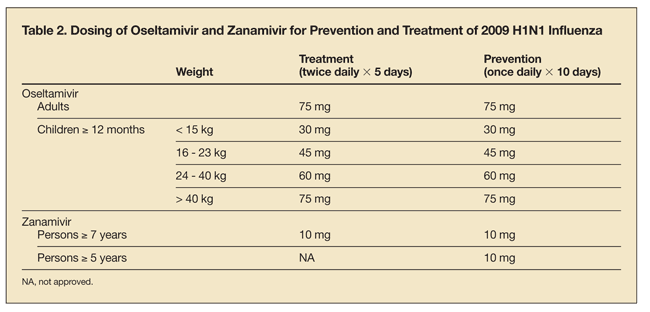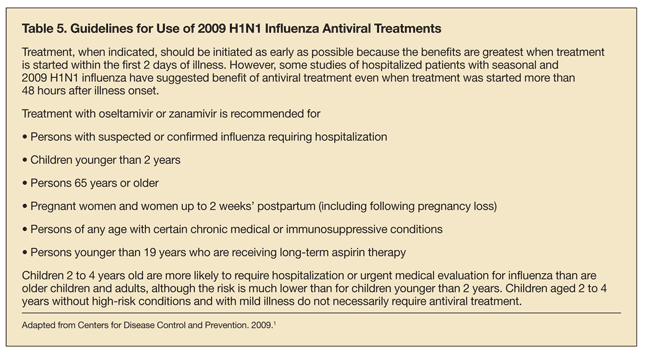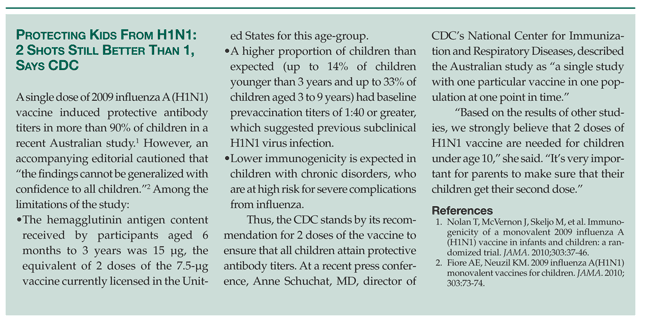
- Clinical Technology
- Adult Immunization
- Hepatology
- Pediatric Immunization
- Screening
- Psychiatry
- Allergy
- Women's Health
- Cardiology
- Pediatrics
- Dermatology
- Endocrinology
- Pain Management
- Gastroenterology
- Infectious Disease
- Obesity Medicine
- Rheumatology
- Nephrology
- Neurology
- Pulmonology
2009 H1N1 Influenza: Antiviral Use for Prevention and Treatment
This discussion reviews the currently available antivirals and recommendations for their use in influenza prophylaxis and treatment. Because our understanding of 2009 H1N1 influenza is still evolving, some off-label use of medications is discussed and noted. Information on 2009 H1N1 is updated frequently, andreaders are encouraged to monitor advisories from federal, state, and local health agencies for up-to-date information. (Drug Benefit Trends. 2010;22:10-14)
Antivirals for influenza prophylaxis and treatment have been available for many years. With the recognition of the 2009 H1N1 influenza A strain, influenza antivirals have taken center stage as health care providers and pharmacists plan and implement a response for safe and effective patient care.

Antiviral Agents for Influenza: Expanded Use
The FDA has approved 2 classes of influenza drugs: adamantanes and neuraminidase inhibitors. The ada-mantane class has been available since 1976, when amantadine was approved for the prevention and treatment of influenza A and B virus infections. Because 2009 H1N1 influenza virus is resistant to adamantanes, only the neuraminidase inhibitors, oseltamivir and zanamivir, are currently recommended as first-line treatments (Table 1).1,2

A summary of the current dosing recommendations for the neuraminidase inhibitors in adults and children is shown in Table 2. A discussion of adverse events and contraindications is included in the guidelines from the CDC.1
The FDA issued emergency use authorization (EUA) for oseltamivir, zanamivir, and the investigational drug peramivir.3,4 This EUA remains in effect as long as the federal government’s designation of a health care emergency continues.3

The expanded uses of oseltamivir and zanamivir are summarized in Table 3. Note that the zanamivir EUA does not change the age limitations for use of this drug. However, the EUA for oseltamivir allows for its use beyond the current labeling in children younger than 1 year (Table 4). More complete information on dosing and the drug’s use in this group is included on the FDA’s influenza Web site.5
In October 2009, the FDA issued an EUA for the investigational intravenous antiviral drug peramivir, which may be used in certain adult and pediatric patients with confirmed or suspected 2009 H1N1 influenza who are admitted to a hospital.6 It is the only intravenous option for the treatment of patients with 2009 H1N1 influenza.6

Management of Patients With Suspected or Proven Influenza
Not every patient with suspected or proven 2009 H1N1 influenza is a candidate for antiviral treatment, according to CDC guidelines.1 The overuse of these medications, as with any antimicrobial medication, can contribute to drug resistance.7
Antiviral medications can reduce the severity and duration of influenza as well as reduce complications and the risk of death. The CDC guidelines currently recommend prompt, timely antiviral use in children and adults who are severely ill, hospitalized, or at high risk for the development of complications (Table 5).1

These guidelines are important and useful; however, clinical judgment and consultation between provider and pharmacist will determine who should receive antiviral medication for influenza treatment or prevention.
At the time of this writing, there were adequate supplies of oseltamivir and zanamivir oral formulations. The CDC released all available doses of oseltamivir oral suspension to state health departments. To ensure adequate supplies, the EUA also allows for the release of certain lots of this drug that may be near or have reached the date of expiration.3 These lots have undergone quality and stability testing under the federal government’s Shelf-Life Extension Program and have been approved for release.8 These lots are not required to be relabeled regarding use beyond their expiration dates, although the FDA Web site states that fact sheets for both patients and health care professionals will be made available. The FDA also offers information on proper storage and temperature requirements for these agents.8 If these stockpiled supplies do not meet the demand, the role of the pharmacist comes into play, since oseltamivir capsules can be compounded into a pediatric suspension.9
Higher-dose oseltamivir as a therapeutic option has also been studied, and it may play a role in treatment of patients who are hospitalized or experience complications. The CDC has noted that higher dosages (150 mg orally, twice daily) were considered for treatment of H5N1 avian influenza as well as H1N1 influenza.10,11 Until there is further information, this dosing regimen can be considered for severely ill hospitalized patients with novel influenza A (H1N1) virus infection.11
Note that these higher dosages of oseltamivir are technically an off-label use of the drug. However, this higher-dosage option could be considered in severely ill patients in anticipation of peramivir use or situations in which peramivir is not available.
Other Therapeutic Options
Recently, statins were reported to be associated with decreased mortality in hospitalized patients with seasonal influenza.12 The use of statins for influenza prophylaxis and treatment was proposed in 2006.12 At that time, Fedson12 discussed the role of statins in the treatment of H5N1 influenza. His hypothesis was that influenza is associated with inflammation and an increased risk of cardiovascular diseases. Therefore, the anti-inflammatory and immunomodulatory effects of statins might also help patients with influenza.
More recently, Vandermeer and colleagues13 concluded that statin use may be associated with reduced mortality in patients hospitalized with influenza. They performed a retrospective review of medical records of 2800 patients who were hospitalized with seasonal influenza in 10 states during the 2007 to 2008 influenza season. In these patients, 17 of 801 who were treated with statins in the hospital (about 2.1%) died of influenza or its complications. Of the 1999 who were not treated with statins in the hospital, 64 died (about 3.2%). This represents a 54% decreased risk of death, considering other risk factors, such as age and use of antiviral drugs.
The study was limited because the statin dose and the duration of treatment could not be determined in these patients. However, Vandermeer and colleagues are continuing this study to determine whether certain statins are associated with better odds of survival.
Although vaccine was not found to be protective in this study, residual confounding from factors not captured by chart review may account for this finding, according to the authors. They speculated that statins may be able to mediate an immune response in addition to being able to lower cholesterol levels.
However, Vandermeer concluded that the results of the study would not be sufficient to make recommendations for prescribing statins for treatment of infectious diseases. These data need to be confirmed by rigorous scientific studies. If further investigation demonstrates that statins are beneficial in patients with influenza, the value of treatment with statins would most likely be in preventing serious complications and death. In order to do this, treatment with statins would probably have to be continued throughout the duration of the illness.
As with any public health concern of this magnitude, health care providers should help patients avoid fraudulent products and claims for influenza. The FDA has dedicated a portion of its Web site to these fraudulent products.14 Providers and patients should be aware of this section to avoid unproven products and claims.
Prophylaxis
Antiviral use in patients with influenza involves both good timing and good clinical judgment. To minimize overuse of antiviral agents and risk of shortages and drug resistance, the CDC guidelines note that antiviral chemoprophylaxis should generally be reserved for persons at higher risk for influenza-related complications who have had contact with someone who had influenza.1
The CDC guidelines note that early recognition and treatment is a preferred alternative to chemoprophylaxis after a suspected exposure. In other words, attempts at widespread or routine prophylaxis for exposed persons should be avoided whenever possible. Persons in close contact with patients in whom influenza is confirmed or suspected should be instructed in recognizing early signs and symptoms of influenza. They should be advised to immediately contact their health care provider for evaluation and possible early treatment if clinical signs or symptoms develop.1
To date, currently circulating 2009 H1N1 viruses are generally susceptible to oseltamivir and zanamivir but resistant to amantadine and rimantadine.6 However, antiviral treatment regimens may change depending on new antiviral resistance or other viral surveillance information.15 At the time of this writing, a third person with oseltamivir-resistant 2009 H1N1 had been identified.
Conclusion
Although the number of patients with H1N1 has been dropping in 2010, these are challenging times for all levels of the health care delivery system. Many of today’s front-line health care providers have never before faced periods of widespread illness with an easily transmissible agent. In addition, misinformation about the safety and efficacy of 2009 H1N1 influenza vaccine as well as the availability of antiviral treatments and vaccination have put additional pressures on health care providers when responding to ill patients.
The role of the federal, state, and local health authorities in managing 2009 H1N1 influenza adds yet another layer of complexity to the problem, one that most health care workers have not faced previously.
At the same time, management of 2009 H1N1 influenza underscores the importance of a multidisciplinary approach to patient care. The current public health emergency also offers opportunities for collaboration between providers and pharmacists that can help improve patient care outcomes.

References:
References
1. Centers for Disease Control and Prevention. Updated Interim Recommendations for the Use
of Antiviral Medications in the Treatment and Prevention of Influenza for the 2009-2010 Season. October 16, 2009. http://www.cdc.gov/h1n1flu/recommendations.htm. Accessed November 1, 2009.
2. Fritsch BF. FDA Update on the H1N1 Flu Vaccine and Antiviral Medications. http://www.fda. gov/downloads/ForHealthProfessionals/UCM185724.pdf. Accessed November 1, 2009.
3. Centers for Disease Control and Prevention. Emergency Use Authorization (EUA) of Medical Products and Devices. October 31, 2009. http://www.cdc.gov/h1n1flu/eua. Accessed November 1, 2009.
4. Food and Drug Administration. Updated Questions and Answers: 2009 H1N1 Flu Virus and Emergency Use Authorization of Tamiflu and Relenza. http://www.fda. gov/NewsEvents/ PublicHealthFocus/ucm153228.htm. Accessed November 1, 2009.
5. Food and Drug Administration. Emergency Use of Tamiflu in Infants Less Than 1 Year of Age. http://www.fda.gov/Drugs/DrugSafety/PostmarketDrugSafetyInformationforPatients andProviders/ucm183870.htm. Accessed February 8, 2010.
6. Food and Drug Administration. Clinicians Considering the Use of Peramivir IV. http://emergency.cdc.gov/h1n1antivirals. Accessed November 1, 2009.
7. Dharan NJ, Gubareva LV, Meyer JJ, et al; Oseltamivir-Resistance Working Group. Infections with oseltamivir-resistant influenza A(H1N1) virus in the United States. JAMA. 2009;301:1034-1041.
8. Food and Drug Administration. Information for Healthcare Professionals-Authorization of Use of Expired Tamiflu for Oral Suspension. October 2, 2009. http://www.fda.gov/Drugs/DrugSafety/PostmarketDrugSafetyInformationforPatientsandProviders/DrugSafetyInformationforHeathcareProfessionals/ucm184770.htm. Accessed November 1, 2009.
9. Centers for Disease Control and Prevention. 2009-2010 Influenza Season: Update for Pharmacists. September 30, 2009. http://www.cdc.gov/H1N1flu/pharmacist/pharmacists_update.htm. Accessed November 1, 2009.
10. Abdel-Ghafar AN, Chotpitayasunondh T, Gao Z, et al. Update on avian influenza A (H5N1) virus infection in humans. N Engl J Med. 2008; 358:261-273.
11. Centers for Disease Control and Prevention. Intensive-care patients with severe novel influenza A (H1N1) virus infection-Michigan, June 2009. MMWR. 2009;58:749-752.
12. Fedson DS. Pandemic influenza: a potential role for statins in treatment and prophylaxis. Clin Infect Dis. 2006;43:199-205.
13. Vandermeer M, Thomas A, Kamimoto L, et al. Role of statins in preventing death among patients hospitalized with lab-confirmed influenza infections. In: Program and abstracts of the 47th Annual Meeting of the Infectious Diseases Society of America; October 29-November 1, 2009; Philadelphia. Abstract 706.
14. Food and Drug Administration. Fraudulent 2009 H1N1 Products List. October 27, 2009. http:// www.accessdata.fda.gov/scripts/h1n1flu. Accessed December 10, 2009.
15. Centers for Disease Control and Prevention. CDC Health Alert Network (HAN) Info Service Message: Three Reports of Oseltamivir Resistant Novel Influenza A (H1N1) Viruses. July 9, 2009. http://www.cdc.gov/h1n1flu/HAN/070909.htm. Accessed November 1, 2009.
Other Resources
• Centers for Disease Control and Prevention 2009 H1N1 Flu Home Page. http://www.cdc.gov/h1n1flu. Accessed November 1, 2009.
• Federal Clearing House for Information on Influenza. Updated daily. http://flu.gov. Accessed November 1, 2009.
• Food and Drug Administration 2009 H1N1 (Swine) Flu Page. http://www.fda.gov/NewsEvents/PublicHealthFocus/ucm150305.htm. Accessed November 1, 2009.
2 Commerce Drive
Cranbury, NJ 08512
All rights reserved.